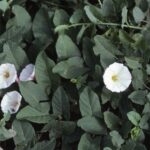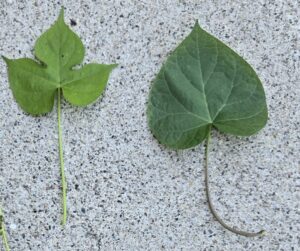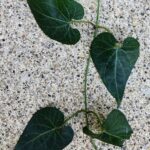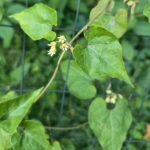Untangling the Vines: Identifying Bindweed, Morning Glory, and Honeyvine Milkweed
Few garden problems cause as much frustration as untangling vines. Sometimes the vines are beautiful climbers planted with intention. Other times, they creep in uninvited and smother everything in their path. Among the most common, and the most confusing, vines in Indiana are bindweed, morning glory, and honeyvine milkweed. To the untrained eye, they look similar: all are fast-growing vines with heart-shaped leaves. However, there are noticeable differences in their physiological traits (Fig. 1) and ecological value. Recognizing the distinctions can improve management and help strike a balance between aesthetics, control, and ecological benefits.
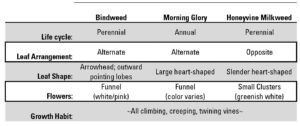
Figure 1. Chart comparing plant traits of bindweed, morning glory, and honeyvine milkweed. Credit: K. Mitchell
Bindweed
(Hedge bindweed: Calystegia sepium; Field bindweed: Convolvulus arvensis)
Bindweed is an aggressive vine with alternate, arrowhead-shaped leaves (Fig. 2) and small white or pink funnel-shaped flowers (Fig. 3). This perennial spreads readily from rhizomes (underground stems), forming vegetative colonies that become increasingly difficult to control. Hedge bindweed and field bindweed differ slightly in appearance, but both are aggressive invaders; in fact, field bindweed is listed as a prohibited noxious weed in Indiana. Cultural control methods, such as cultivation or light exclusion, can take 3 to 5 years to achieve eradication. The best results often come from combining these approaches with carefully timed herbicide applications.
- Figure 2. Bindweed leaves are arrowhead-shaped with the basal lobes pointing outwards. With an alternate leaf arrangement, each node has only one leaf. Credit: K. Mitchell
- Figure 3. Bindweed has white or pink funnel-shaped flowers. Field bindweed flowers (shown here) are typically less than an inch. Hedge bindweed has slightly larger flowers that can be 1 to 3 inches. Credit: Purdue Weed Science
Morning Glory
(Ipomoea spp.)
Morning glories are a familiar vine often planted intentionally for their large, colorful flowers. Unlike bindweed, morning glory is an annual and dies off in winter. However, its abundant seed production allows it to return year after year. A single vigorous vine can produce hundreds of colorful, funnel-shaped flowers (Fig. 4) resulting in over a thousand seeds which may remain viable in the soil for decades. Morning glory will become weedy if left unmanaged. Thoughtful containment and regular deadheading can help to keep it under control.

Figure 4. Morning glory produces colorful, funnel-shaped flowers that can be 2 to 4 inches. Credit: K. Mitchell
Two types are most often seen (Fig. 5):
- Common morning glory (Ipomoea purpurea) has large, heart-shaped leaves and showy, funnel-shaped flowers in a wide variety of colors.
- Ivy-leaf morning glory (Ipomoea hederacea) has leaves with three distinct lobes that resemble ivy, and its smaller flowers are typically light blue or purple with white.
Honeyvine Milkweed
(Cynanchum laeve)
Honeyvine milkweed has slender heart-shaped leaves like bindweed, but unlike bindweed, this native vine provides ecological value as a food source for monarch caterpillars. It’s easily distinguished from morning glory and bindweed by its opposite leaf arrangement (Fig. 6), small clusters of greenish-white flowers (Fig. 7), and long seed pods, typical of the milkweed family, that release hundreds of windblown seeds. While beneficial to pollinators, honeyvine can overwhelm a home landscape and should be contained to naturalized areas or pollinator gardens.
- Figure 6. Honeyvine milkweed has slender, heart-shaped leaves in an opposite arrangement (two leaves per node). Credit: K. Mitchell
- Figure 7. Honeyvine milkweed has clusters of small, greenish-white starlike flowers. Credit: K.Mitchell
Correct identification is the first step toward effective management. Though bindweed, morning glory, and honeyvine milkweed are all fast-growing vines, they have key differences in their physiological traits and ecological value. Proper identification determines whether you are eradicating noxious weeds, containing ornamentals, or conserving natives where appropriate.
Quick Tips for Identification
- Leaf arrangement:
- Alternating leaves (only one leaf per node) – bindweed or morning glory
- Opposite leaves (two leaves per node) – honeyvine milkweed
- Flowers:
- White or pink funnel-shaped (~1 to 3 in) – bindweed
- Colorful funnel-shaped (2 to 4 in) – morning glory
- Small, greenish white clusters – honeyvine milkweed
- Seed pods:
- Tiny capsules – bindweed or morning glory
- Long pods with silky seeds – honeyvine milkweed
Resources
Purdue University, Dept of Botany & Plant Pathology. Noxious and Invasive Weeds and the Weed Laws in Indiana. Purdue Extension, March 2021.
University of California – Statewide IPM Program). Field Bindweed. University of California ANR, Oct. 2011.
https://ipm.ucanr.edu/home-and-landscape/field-bindweed
Purdue University, Dept of Horticulture & Landscape Architecture. Honeyvine Milkweed. Purdue Facts for Fancy Fruits, Aug. 2023.
https://fff.hort.purdue.edu/article/honeyvine-milkweed/

